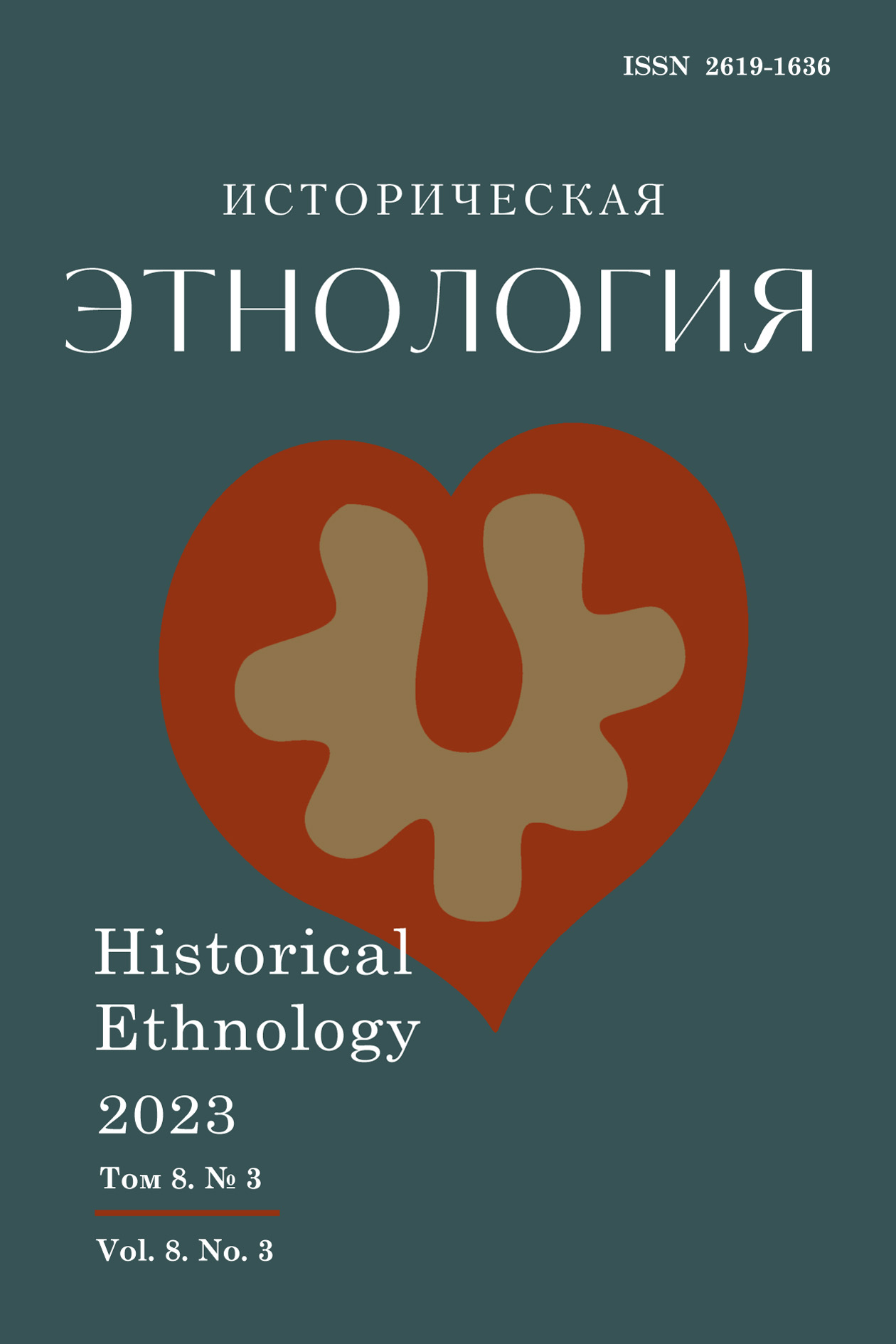High-relief coinage in the Kazan-Tatar jewelry tradition: historical and technical analysis
Donina L.N.
374-388 p.
doi.org: 10.22378/he.2023-8-3.374-388
The article is devoted to identifying the origins and regional features of the technology of high-relief coinage in the Kazan-Tatar jewelry tradition. The main source was the electronic database of Tatar jewelry from museum collections, collected within the framework of the academic project “Jewelry of the Turkic peoples of Eurasia: general and special” (Russian Foundation for Basic Research 2013–2014, No. 13-06-97056). The research was based on a systematic technical and stylistic analysis of traditional jewelry and a detailed synchronous-diachronic examination of Bulgar-Golden Horde and Tatar products with three-dimensional images. Reconstruction of technological techniques related to this type of artistic metal processing made it possible to identify specific features of the formation of decor. The manual method of obtaining a unique relief using punches with a figured striker predominated. The decorations are characterized by the following: two or three-level bas-relief, the absence of a “locking” profile, the principle of “compositing” that underlies the conventionally interpreted floral and plant motifs, geometric orderliness, subject to the laws of the central-radial composition. The completed form of the decoration corresponds to the typical features of “notch chasing”, which is a marker of the Tatar craft tradition: smooth relief and “grain” background. An integrated approach allowed us to conclude that the origins of the existing artistic and figurative system can be traced in artifacts of the Bulgarian and Golden Horde silver of the 11th–14th centuries, made by embossing, stamping, and punching on a matrix. The formation of technological features was influenced by the traditions of high-relief coinage, which received regional development among Kazan silversmiths in the 17th–18th centuries. The specifics of Tatar relief coinage as a whole were formed in the context of Islamic art.
Keywords: molding, displacement, embossing, stamping, punching, ornament, Golden Horde, Bulgarian toreutics
For citation: Donina L.N. (2023) High-relief coinage in the Kazan-Tatar jewelry tradition: historical and technical analysis. Istoricheskaya etnologiya [Historical Ethnology]. Vol. 8. No. 3: 374–388. DOI: 10.22378/he.2023-8-3.374-388 (In Russ.)
REFERENCES
Brepol’ E. (1982) Theory and practice of jewelry making. Leningrad: Leningrad branch of Mechanical Engineering Publ. (In Russ.)
Donina L.N., Suslova S.V. (2018) Tatar jewelry art: On the manifestations of Tatar-Russian syncretism in the craft traditions of the Kazan Volga Region. Istoricheskaya etnologiya [Historical Ethnology]. Vol. 3. No. 1: 69–80. DOI: 10.22378/he.2018-3-1.69-80 (In Russ.)
Donina L.N., Suslova S.V. (2022) On the Jochid heritage in the jewelry traditions of the Kazan Tatars: The art of coinage. Etnografiya [Ethnography]. No. 1(15): 133–159. (In Russ.)
Efimova A.M. (1960) Butaevsky treasure of jewelry from the Volga Bulgars. Sovetskaya arheologiya [Soviet Archeology]. No. 3: 195–202. (In Russ.)
Gil’dt V. (1913) Jewelry and metal craft in Russia. In: Handicraft industry of Russia. St. Petersburg: Yakor’ Typo-Lithography: 3–16. (In Russ.)
Gol’dberg T.G., Mishukov F.Ya., Platonova N.G, Postnikova-Loseva M.M. (1967) Russian gold and silver crafting of the 15th–20th centuries. Moscow: Nauka Publ. (In Russ.)
Kazakov E.P. (1991) Bulgar village of the 10th–13th centuries in the lower reaches of the Kama River. Kazan: Tatar Book Publ. (In Russ.)
Kazakov E.P. (1992) Culture of early Volga Bulgaria (stages of ethnocultural history). Moscow: Nauka Publ. (In Russ.)
Klyuchevskaya E.P. (2009) Dictionary of Kazan artists. Second half of the 16th – beginning of the 20th century. St-Petersburg: Slaviya Publ. (In Russ.)
Mal’m V.A. (1980) Decorations of a woman’s headdress from the Simferopol treasure. In: Proceedings of the State Historical Museum. Moscow. Vol. 51: 140–144. (In Russ.)
Minasyan R.S. (2014) Metalworking in ancient times and the Middle Ages. St. Petersburg: State Hermitage House Publ. (In Russ.)
Novikov V.P., Pavlov V.S. (1991) Handmade jewelry. Leningrad: Politekhnika Publ. (In Russ.)
Pavlinskaya L.R. (2018) Traditional technique of artistic metal processing of the Buryats: Turkic-Mongolian ethnocultural parallels. In: Jewelry of the Turkic peoples of Eurasia. Historical and ethnographic essays. Kazan: RT AS Sh. Marjani Institute of History: 225–252. (In Russ.)
Polyakova G.F. (1996) Products from non-ferrous and precious metals. In: City of Bolgar: Craft of metallurgists, blacksmiths, foundry workers. Kazan: RT AS G.Ibragimov Institute of Language, Literature and Arts: 154–257. (In Russ.)
Postnikova-Loseva M.M. (1974) Russian jewelry art, its centers and masters. 16th–19th centuries. Moscov: Nauka Publ. (In Russ.)
Postnikova-Loseva M.M. (1981) Russian gold and silver filigree. Moscow: Iskusstvo Publ. (In Russ.)
Rudenko K.A. (2011) Bulgarian gold. Filigree temple pendants. Kazan: Zaman Publ. (In Russ.)
Rudenko K.A. (2015) Bulgarian silver. Antiquities of Bilyar. Kazan: Zaman Publ. (In Russ.)
Rudenko K.A. (2013) Toreutics of Volga Bulgaria and the Bulgarian Ulus of the Golden Horde: The problem of continuity. Povolzhskaya arheologiya [Volga archeology]. No. 4(6): 34–46. (In Russ.)
Smirnov A.P. (1962) Bronze headband from the Volga Region. In: Brief reports on reports and field research of the Institute of Archeology. Vol. 89. Moscow: USSR Academy of Sciences: 115–117. (In Russ.)
Treasures of the Golden Horde. Exhibition catalogue. (2000) St. Petersburg: Slavia Publ. (In Russ.)
Treasures of the Ob’ Region. Exhibition catalogue. (1996) St. Petersburg: Formica Publ. (In Russ.)
Vorob’ev N.I., Busygin E.P. (1957) Artistic crafts of Tataria in the past and present. Kazan: State Museum of the Tatar ASSR. (In Russ.)
About the author: Larisa N. Donina, Cand. Sc. (Art History), Senior Research Fellow at the Department of Ethnological Research, Marjani Institute of History of the Tatarstan Academy of Sciences (7A, Baturin St., Kazan 420111, Russian Federation); lis.art@mail.ru
Received September 1, 2023 Accepted for publication November 3, 2023
Published Online December 4, 2023
|
|








